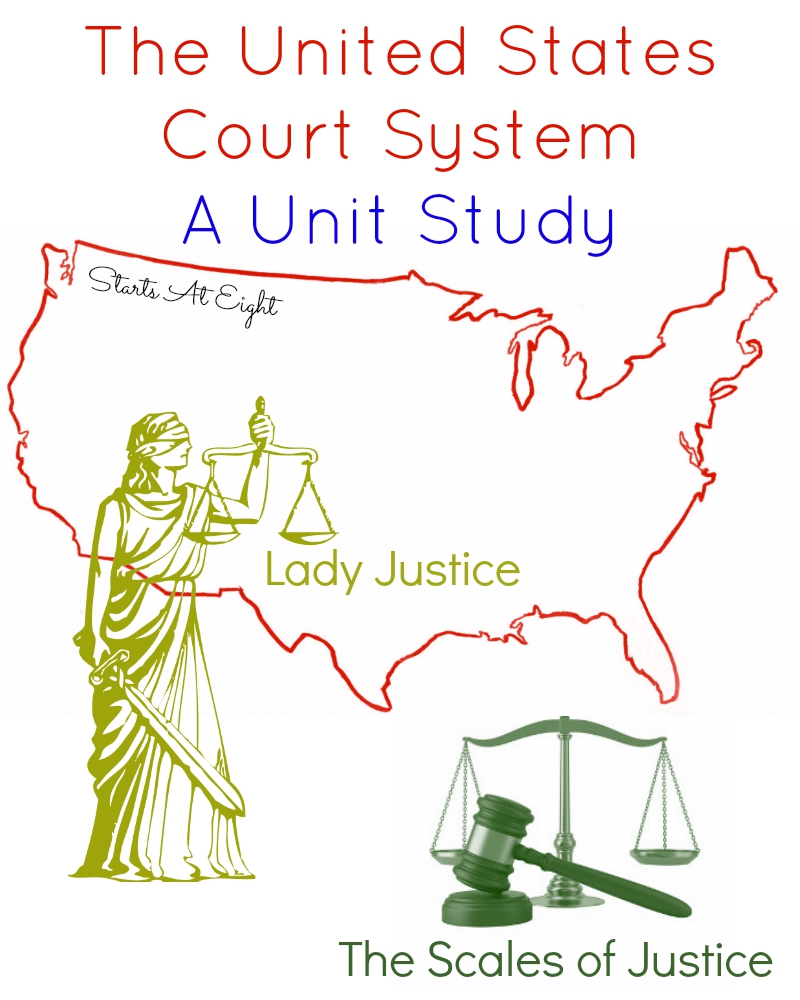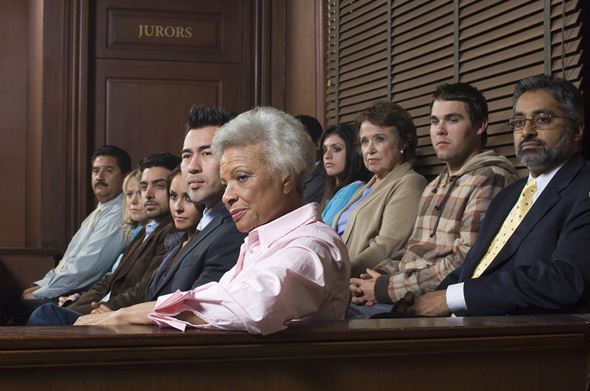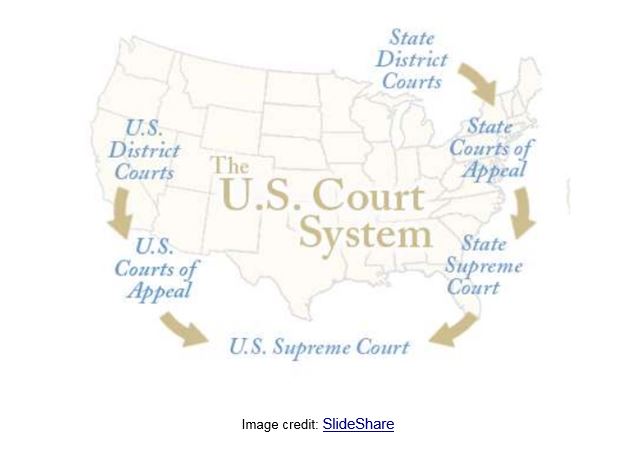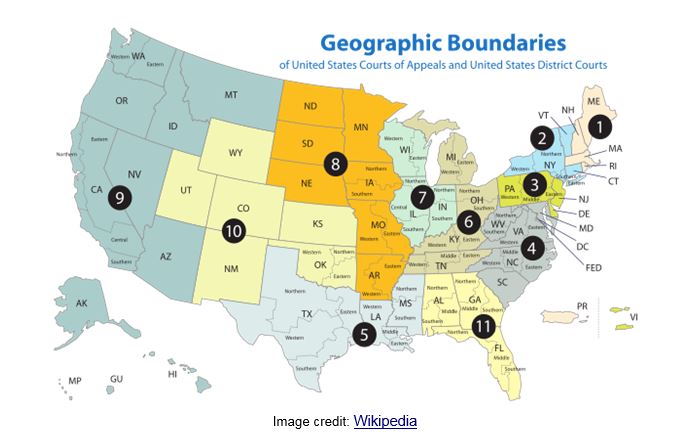The United States Court System: A Unit Study – Part 1
In America we have a justice system with many court layers with one purpose in mind – justice. Justice for both the criminal and the victim. Finding the truth in any situation, whether criminal or civil, can be difficult. Judging a situation so that the guilty party is punished properly takes patience to discover the truth, knowledge of the laws and wisdom to know who to believe, who should be punished and how.

What Do Courts Do?
Courts have a very simple, and yet complex, task – apply the law to an actual situation. Laws can be very confusing and hard to interpret. There may be dozens of laws that apply to a specific situation – and it is the court’s job, by either a judge or jury, to navigate the specific situation and determine which laws apply in this case.
Criminal Cases
In a criminal case, the government brings charges against a person alleging they have broken the law. The court must decide if the person in question has indeed broken the law, or is innocent. If the person is guilty, then the punishment must also be determined.
Civil Cases
In civil lawsuits, the court must settle a disagreement between two parties – citizens, businesses, government entities, community organizations and more. These disagreements can be over various issues such as car accidents, broken contracts, divorce, violation of Constitutional rights and more.
The United States Court System may seem complex, but it can be categorized into several layers.
There are two main jurisdictions:
- Federal Court
- State Court
Federal Courts
The lowest level of the federal court system is the 10 United States District Courts spread throughout the US. Each court has an assigned geographical area they hear cases from – both criminal and civil lawsuits can be filed in this court system. Trials will be heard by either a jury or a judge.
The United States District Courts hear cases about:
- Federal laws
- Constitutional rights
- Disputes between 2 states
- Citizen disputes that are 2 different states
- Issues between state governments and a foreign government
- When ambassadors have complaints with a foreign government
- Settling problems with federal taxes and customs
- Deciding cases about people becoming US citizens
If a case is appealed after a trial in a US District Court, it moves to the US Court of Appeals. By nature, the US Court of Appeals hears the same type of cases as US District Courts do. The US Court of Appeals does not have a second trial for a case when it is appealed to them. Instead, judges review decisions of the district court to determine if the law was correctly interpreted and applied. When they review the case, only the written legal arguments of both parties (called briefs), physical evidence, paperwork, and transcripts of the case is involved. Transcripts are a chronological, written document of everything that was said at a trial.
The United States Supreme Court, which is made up of a panel of judges, has the final say on cases that are appealed from both Federal and State courts.
State Courts
State courts, divided into District Court, Circuit Court (sometimes called Court of Appeals) and Supreme Court, handle the vast majority of both criminal and civil cases. Each state has their own court system, which is divided into smaller jurisdictions. Generally each county seat has both a District and Circuit Court, though it varies based on population of each area.
District Court includes traffic cases such as speeding, parking tickets or car accidents, as well as more serious criminal cases such as assault, theft or drunk driving. Civil cases cover a broad spectrum as well – bankruptcies, divorces, eviction or debt collection. Cases filed in District Court are presided over by a judge who will hear the case and pass judgement accordingly.
If a case is appealed, it will go to Circuit Court, where a second trial will be conducted. At this point, a circuit judge can hear the trial. If one party requests a jury, it will be granted. This makes a case more involved procedurally, but it is a precious right that each American citizen has – to be tried and judged by their peers in the local community.
After a trial in a Circuit Court, a case can be appealed to the State Supreme Court. The Supreme Court does not hold trials. Much like the US Court of Appeals, the court will merely review the lower court’s ruling, trial transcripts, legal briefings and evidence for errors in the application of the law. If such an error is discovered, the lower court’s ruling can be overturned. Often the case is sent back to the lower court for a new trial. If no errors are found, the lower court’s ruling is upheld.
What is a Jury?

In the United States, every person accused of a crime punishable by 6 or more months of jail time has a Constitutional right to a trial by jury. A jury trial, or a trial by jury, is a panel of citizens who is selected to judge the facts of a case and determine if the party in question is guilty or innocent. Both civil and criminal cases can be tried by a jury.
Jury members are chosen randomly and served subpoena papers by local law enforcement to appear for jury duty on specific days. Once prospective jury members arrive they are asked questions by the judge and both party’s attorneys. Slowly, jury members are dismissed if they might be biased for some reason, know one of the parties involved or serving on a jury trial would cause them undue hardship (such as medical reasons). A civil jury consists of 6 to 12 members, while a criminal jury always has 12 members.
A jury considers the facts of evidence, testimony of witnesses and the facts of law (as guided by the judge) to determine the guilt or innocence of the person(s) on trial, while the judge usually rules on the facts of law.
A judge presides over the case to enforce court rules, set deadlines for procedural steps before the trial, allow or disallow certain evidence in the trial, keep the courtroom in order, facilitate the trial procedure and guide the jury in the applicable law with the input of both party’s attorneys. The judge remains neutral throughout the trial process.
What Does it Mean to “Appeal” a Case?
When a lower court has issued a ruling, often times one party is not satisfied. Wanting a higher court to issue another official legal opinion or ruling is the goal – sometimes one party feels the law was not interpreted correctly, evidence was suppressed or the ruling was unfair and biased. Sometimes parties will appeal a case simply because they do not agree with the ruling and hope for a different ruling from a higher court.
Stay tuned for Part 2 next week, where we’ll discover the jobs of various court personnel and learn about the Scales of Justice, Lady Justice and many extension activities!
Author Bio: Carrie Thompson, a homeschool graduate, enjoys writing, editing and blogging – particularly for kids. When not at her computer working, Carrie enjoys hiking the Blue Ridge Mountains or kayaking down the James River with friends and family.





Finishing Strong #62 - Eva Varga
October 7, 2015 @ 6:01 am
[…] next post I would like to highlight is from Heidi at Starts at Eight, The United States Court System: A Unit Study, Part 1. The judicial system is one area of social studies that we haven’t spent much time […]
U.S. Government- High School | farmschooliowa
March 1, 2016 @ 9:24 am
[…] American Courts Part 1 – […]
Finishing Strong – Homeschooling Middle & High School #88
May 11, 2016 @ 6:01 am
[…] The United States Court System: A Unit Study – by Starts at […]
Homeschooling the Middle & High School Years 140 - Blog, She Wrote
October 25, 2017 @ 10:19 am
[…] The United States Court System: A Unit Study Part 1 by Starts at Eight […]